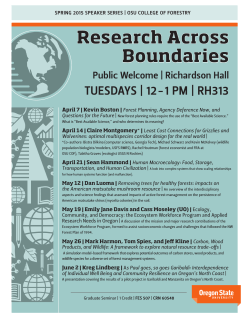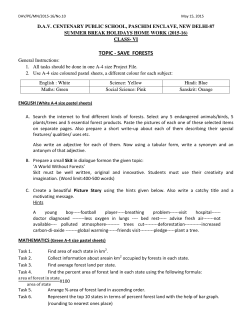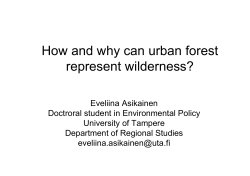
TENTATIVE AGENDA - IUFRO Nice 2015
TENTATIVE AGENDA This conference, entitled "Global Challenges of Air Pollution and Climate Change to Forests", will be held at the "Palais de la Méditerranée" in Nice (France) on June 2-5, 2015, back-to-back with the COST Action "GreenInUrbs" meeting on 1st June 2015. All sessions, coffee breaks and wine tasting are in room Venitien, poster sessions and lunches are in room Azur. Monday 1st June, 2015 9:00-18:00 - COST Action FP1204 "GreenInUrbs" Working Group meetings - 3rd floor Rooms Charleston, Fox Trot and Pasodoble 18:00-19:30 – Meeting for IUFRO Task Force „Climate Change and Forest Health‟ members only (Room Charleston) Tuesday 2nd June, 2015 8:00-8:30 - Registration of participants IUFRO 8:30-12:30 - COST parallel session - 3rd floor - COST Action FP1204 members only 8:30-12:30 - IUFRO parallel session - 1st floor 8:30-10:00 - Opening remarks by local organizer, Elena Paoletti (IUFRO), Danilo Mollicone (FAO), Manuel Nicolas (National Forests Office) and Philippe Mondielli (Foundation “Prince Albert II de Monaco”) 10:00-10:30 - Coffee break 10:30-12:30 - Session 1 Environmental status and health of Mediterranean forest ecosystems Chairs: Elena Paoletti and Pierre Sicard 10:30 De Marco 10:45 Fenn 11:00 Gratani 11:15 Dalstein-Richier 11:30 Branquinho The Mediterranean forests as a critical target for air pollution and climate change Effects of nitrogen deposition and ozone on tree growth and mortality in California forests The evergreen species response to Mediterranean climate stress factors Health and vitality of two pine species in the context of climate change in Southern Europe Functional diversity as an indicator of ecosystem transitions 11:45 Cariñanos 12:00 Ugarković 12:15 Fares between sub-humid and semi-arid in Mediterranean areas Phenological trends and effects of climate change in oak forests of south-eastern Spain Microclimate of the Holm oak (Quercus ilex L.) forest and degradation stages of maquis and garrigue in the area of Mediterranean Croatia Multiple interactions between anthropogenic pollutants, greenhouse gases and biogenic volatile organic compounds in a Holm oak peri-urban forest 12:30-14:00 - Lunch 14:00-16:30 - Session 2 Impacts of air pollution and climate change on forests in the wildland-urban interface Chairs: Carlo Calfapietra and Algirdas Augustaitis 14:00 Calfapietra 14:15 Verlič 14:30 Sgrigna 14:45 15:00 Samson Calatayud 15:15 Wang 15:30 Silaghi 15:45 Watanabe 16:00 Rupel 16:15 Ellsworth Towards a network of urban forest eddy covariance stations: an innovative case study in Naples Harmonized monitoring of urban and periurban forests in European cities – Examples of Milano and Ljubljana Particulate Matter deposition on leaves across European urban environments: Platanus sp. sampling campaign within COST Action FP1204 Impact of PM deposition on urban trees Responses of four common urban trees in China to elevated ozone Periodic drought influences the effects of elevated ozone on growth and physiology of Shantung maple Radial growth response of Quercus robur trees to ambient air pollution in a Bucharest periurban forest, Romania Difference in photosynthetic responses to ozone between canopy positions in Japanese oak Slovenian forests, urban forests and periurban forests are endangered from pollution by air (ozone) Effect of drought and elevated CO2 on volatile carbon emissions for Eucalyptus in a periurban forest 16:30-17:00 - Coffee break 17:00-17:15 - Introduction to the Green Path site visit by Zürcher N. (Consulting Arborist) “Living with Urban Trees: Accommodating Their Needs, Enhancing the Benefits”. 17:15-18:30 - Guided visit to the "Green path" in Nice - Jean-Michel Meuriot and Alexis Maia; botany experts from the Botanical Garden of Nice. 18:30-20:00 - Wine tasting and poster session 2 Wednesday 3rd June, 2015 8:30-10:05 - Session 3 Physiological and genetic mechanisms underlying stress responses of forest trees and forest ecosystems Chair: Om Rajora 8:30 Rajora Effects of climate change on gene expression and associated physiological processes in a boreal conifer 8:50 Oksanen Adaptation and acclimation of silver birch (Betula pendula) provenances in a common garden experiment 9:05 Bahadur Determining the frost tolerance potential of commercially important Eucalyptus species in South Africa 9:20 David-Schwartz Genetic variation in cavitation resistance driven by anatomical traits in Pinus halepensis 9:35 Le Thiec Distinct responses to ozone of stomata in three poplar genotypes 9:50 Chen Proteome analysis of proteins responsive to ambient and elevated ozone in Machilus pauhoi kanehira seedlings 10:05-10:30 - Coffee break 10:30-12:05 - Session 3 Physiological and genetic mechanisms underlying stress responses of forest trees and forest ecosystems Chair: Rainer Matyssek 10:30 Matyssek Can we link genetic control with physiological activity? Exemplifying beech response (Fagus sylvatica) to oxidative stress 10:50 Wieser Is it all genetics? New evidence on an old issue 11:05 Velikova Biogenic volatile isoprenoids – strategies for sustainable forestation in changing environment 11:20 Mikkelsen UV-induced N2O emission from plants 11:35 Sõber Acclimation of deciduous trees to increasing air humidity and interacting environmental drivers 11:50 Koike Plant defense and photosynthesis of Japanese white birch saplings grown under a free-air O3 fumigation system 12:05-13:30 - Lunch 3 13:30-16:00 - Session 4 Health and growth of forests: bridging monitoring and modeling Chair: Alessandra De Marco 13:30 de Vries 13:45 Escobedo 14:00 Feng 14:15 Hoshika 14:30 Moura 14:45 Melo 15:00 Rizzetto 15:15 Badea 15:30 Seidling 15:45 Liampas Assessment of impacts of nitrogen deposition, ozone exposure and climate change on carbon sequestration by monitoring and modeling Modeling and mapping the spatial and temporal effects of landuse and climate change on forest ecosystem services A stomatal ozone flux-response relationship for five poplar clones widely planted in China To develop stomatal conductance modeling under elevated ozone in forest trees Variation in O3 symptom development in plants exposed to tropical environments Prediction of geographic distribution of endangered species of the Brazilian Atlantic forest Modelling the impact of climate change and atmospheric N deposition on French forests biodiversity Effect of climate change on tree growth from intensive forest monitoring network in Romania Accumulating influences on individual parameters of tree performance Hellenic Positioning System (HEPOS) in the service of accuracy control in semi-mountainous area 16:00-16:30 - Coffee break 16:30-17:45 - Session 4 Health and growth of forests: bridging monitoring and modeling Chair: Salim Belyazid 16.30 Ledermann 16.45 Kozlov 17.00 Ferretti 17.15 Schaub 17:30 Andivia Analyzing site productivity and stand risk of Norway spruce (Picea abies [L.] Karst.) in Austria Confirmation bias affects the results of monitoring: a case of leaf fluctuating asymmetry Monitoring and modeling the long-term impact of air pollution on forest health and growth in Europe Ozone risk assessment for European forests – A ten-year study on permanent monitoring plots A process-based soil-plant model to assess nutritional limitations on forest growth within a changing environment 17:45-19:00 - Poster session and voting for the best poster award 19:00-20:00 - Meeting for IUFRO RG 7.01 officers only (room Venitien) 4 19:30 to Midnight - Cabaret dinner “Chez Fanny” (Meeting point: Palais de la Méditerrannée, transfer by bus for participants and by car for IUFRO officers from 20:00). 5 Thursday 4th June, 2015 8:30-12:00 - Session 5 Biogeochemistry and multiple stressors Chairs: Nancy Grulke and He Shang 8:30 8:40 Grulke Grote 8:55 Domingos 9:10 9:25 Fuentes Grulke 9:40 Braun 9:55 Vollenweider Introduction to the session BVOC emissions from trees - forming ozone or protecting against ozone? PAHs and heavy metals in forest remnants in the centraleastern of São Paulo State, SE Brazil Influence of air pollution on plant-insect interactions The role of abiotic and biotic stressors in pine susceptibility to bark beetle Tree mortality in Swiss forest observation plots: the role of drought, nutrition, and N-deposition Response of low-elevation pine stands in the Central Alps to changes in land use in a warmer climate 10:10-10:30 Coffee break 10:30 Alonso 10:45 Hayes 11:00 De Witte 11:15 Pickles 11:30 Nickel 11:45 Belyazid Interactive effects of O3, N, and climate on annual understory pastures of Holm oak forests Combined effects of O3 and N on ecosystem services: experimental results and modelled future impacts Changes in ectomycorrhizal species composition along a Ndeposition gradient in Swiss beech forests Success of migrated Douglas-fir seedlings is mediated by ectomycorrhizae and other soil factors Effect of climate change and atmospheric nitrogen deposition on ecological integrity of forests Integrated effects of atmospheric deposition and climate change on forest ecosystem services 12:00-13:30 - Lunch 6 13:30-16:45 - Session 6 Forest ecosystems, atmospheric deposition and the water cycle Chairs: Yusuf Serengil and Mark Fenn 13:30 Malek 13:45 Serengil 14:00 Vilhar 14:15 Krecek 14:30 Balestrini 14:45 Du 15:00 García-Gómez 15:15 Hůnová 15:30 Schröder 15:45 McNulty 16:00 Pascaud 16:15 Ning 16:30 Saenger The impact of deforestation on the localization of springs and their chemistry on Skrzyczne in the Beskid Śląski Mts. A hydrological evaluation of forest fragmentation along urban-rural transition using SWAT model Influence of conversion of spruce monocultures into mixed beech - spruce forests on the river basin runoff Long term impacts of biomass harvesting on hydrology and nutrient leaching of boreal forests Long-term patterns of deposition, soil solution and stream water chemistry in an Alpine forest ecosystem Inorganic nitrogen deposition in China's forests: Status and characteristics Atmospheric concentration and deposition of nitrogen in four Mediterranean holm oak forests A novel approach for spatial quantification of nitrogen deposition: A case study for Czech forests Concentrations of heavy metals in moss and natural surface soil sampled in Norway from 1990 to 2010 Where no forest has gone before: New forest stress response patterns and adaptive management options Impact of base cation deposition trends on exceedances of critical load of acidity in French forests Response of urban oak species to flooding and elevated CO2 in the Gulf Coast region of USA Changes in nutrient and carbon stocks in French forest soils under decreasing atmospheric deposition 16:45-17:00 - Closing ceremony with delivery of the best poster award - Closing remarks by Mr. Eric Ciotti, President of the General Council 19:00 to Midnight - Gala dinner (Meeting point: Palais de la Méditerrannée, transfer by bus) 7 Friday 5th June, 2015 9:00-9:45 Transfer by bus from Nice to Cannes 10:00-10:15 Transfer by boat from Cannes to Lérins island 10:15-10:40 Coffee break with a talk given by the local Forest ranger (National Forests Office) 10:45-12:15 Free time along the botanical path to discover an exceptional Mediterranean flora 12:30-14:00 Bucolic/pastoral “Provençal” lunch 14:15-14:30 Transfer by boat from Lérins island to Cannes 14:40-15:10 Transfer by bus from Cannes to Grasse 15:15-15:25 Perfurmer (Nose) conference at the Flower Factory 15:30-16:30 Visit of the historic Perfumery Fragonard in Grasse 16:40-17:15 Coffee break with three talks: Dr. Thierry Gauquelin (Mediterranean Institute of marine and terrestrial Biodiversity and Ecology, France) “The Oak Observatory O3HP: interdisciplinary and experimental approaches to study Mediterranean forest functioning under climate change”. Prof. Jose D. Fuentes (Department of Meteorology - The Pennsylvania State University, USA) “Flowers' fragrance diminished by air pollution - What are the consequences for perfume industry and biodiversity?” Dr. Martine Adrian-Scotto (Chemistry Institute in Nice, ICN) “The national research group Odourant, Odour and Olfaction”. 17:20-18:00 Visit of Grasse old-center 18:00-18:45: Transfer by bus to Nice Contact : contactus@iufro-nice2015.com 8
© Copyright 2025










